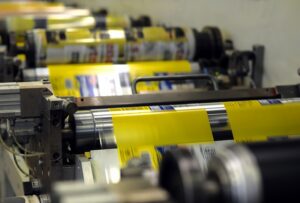Introduction:
Printing ink is an essential component of the printing process. It is responsible for creating the image on the substrate, whether it is paper, fabric, or any other material. The quality of the ink used can determine the overall quality of the print. In this article, we will discuss the different types of printing inks available and their properties.
I. Oil-Based Inks
Oil-based inks are the oldest and most traditional type of printing ink. They are typically used in letterpress and offset printing. These inks are made from pigments that are suspended in a carrier oil, which can be vegetable oil or mineral oil. Oil-based inks are known for their ability to produce sharp and detailed images. They take longer to dry than other types of inks, but they are more durable and can withstand exposure to sunlight and weathering. However, they are not suitable for printing on non-porous materials.
II. Water-Based Inks
Water-based inks are the most eco-friendly of all the ink types. They are made using water as a carrier instead of solvents, making them non-toxic and biodegradable. These inks are commonly used in flexographic and gravure printing. They dry faster than oil-based inks and are ideal for printing on absorbent materials like paper, cardboard, and fabrics. However, they may not be as durable as other types of inks.
III. UV Inks
UV inks are a type of ink that is cured using ultraviolet light. They are typically used in screen printing, digital printing, and flexographic printing. These inks dry almost instantly when exposed to UV light, making them ideal for high-speed printing applications. UV inks are also resistant to fading and weathering, making them ideal for outdoor applications. However, they may be more expensive than other types of inks.
IV. Solvent-Based Inks
Solvent-based inks use solvents like ethyl acetate, toluene, and acetone as carriers. They are used in applications where fast drying is necessary, such as in the printing of plastics, metals, and other non-porous surfaces. Solvent-based inks are also used in large format printing, such as billboards and banners. They may not be as eco-friendly as water-based inks and may require proper ventilation due to the solvents used.
V. Dye-Based Inks
Dye-based inks are a type of ink that uses dyes instead of pigments. They are commonly used in inkjet printers, which are commonly used for home and office use. Dye-based inks are less expensive than pigment-based inks, but they tend to fade more quickly and are less resistant to water and other environmental factors. However, they are suitable for printing on various types of paper.
VI. Pigment-Based Inks
Pigment-based inks are a type of ink that uses pigments instead of dyes. They are commonly used in inkjet printers and are more expensive than dye-based inks. Pigment-based inks are more resistant to fading and water, making them ideal for printing photographs and other high-quality images. They are also suitable for printing on various types of paper.
Conclusion:
In conclusion, the type of ink used in printing will depend on the application and the material being printed. Oil-based inks are best for sharp and detailed images, water-based inks are eco-friendly and ideal for printing on absorbent materials, UV inks are quick drying and resistant to fading, solvent-based inks are best for printing on non-porous surfaces, dye-based inks are affordable but less resistant to fading, and pigment-based inks are best for high-quality images









